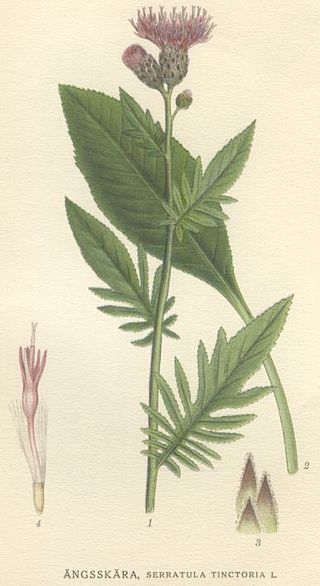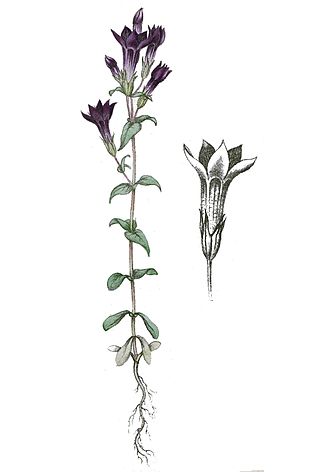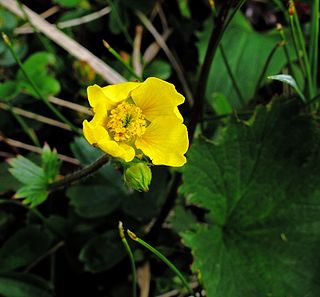
The United States Department of Agriculture (USDA) is the federal executive department responsible for developing and executing federal laws related to farming, forestry, rural economic development, and food. It aims to meet the needs of commercial farming and livestock food production, promotes agricultural trade and production, works to assure food safety, protects natural resources, fosters rural communities and works to end hunger in the United States and internationally. It is headed by the secretary of agriculture, who reports directly to the president of the United States and is a member of the president's Cabinet. The current secretary is Tom Vilsack, who has served since February 24, 2021.
Natural Resources Conservation Service (NRCS), formerly known as the Soil Conservation Service (SCS), is an agency of the United States Department of Agriculture (USDA) that provides technical assistance to farmers and other private landowners and managers.

Saussurea is a genus of about 300 species of flowering plants in the tribe Cardueae within the family Asteraceae, native to cool temperate and arctic regions of East Asia, Europe, and North America, with the highest diversity in alpine habitats in the Himalayas and East Asia. Common names include saw-wort and snow lotus, the latter used for a number of high altitude species in East Asia.

Chippewa National Forest is a National Forest located in north central Minnesota, United States, in the counties of Itasca, Cass and Beltrami. Forest headquarters are located in Cass Lake, Minnesota. There are local ranger district offices in Blackduck, Deer River and Walker.

Serratula is a genus of plants in the tribe Cardueae within the family Asteraceae native to Eurasia. Plumeless saw-wort is a common name for plants in this genus. Serratula as traditionally defined contains at least two groups: one of which is basal within the subtribe Centaureinae and one of which is derived; the former group can be moved to the genus Klasea.

Gentianella amarella, the autumn gentian, autumn dwarf gentian, or autumn felwort, is a short biennial plant flowering plant in the gentian family, Gentianaceae. It is found throughout Northern Europe, the western and northern United States, and Canada.
Private landowner assistance program (PLAP) is a class of government assistance program available throughout the U.S. for landowners interested in maintaining, developing, improving and protecting wildlife on their property. Each state provides various programs that assist landowners in agriculture, forestry and conserving wildlife habitat. This helps landowners in the practice of good land stewardship and provides multiple benefits to the environment. Some states offer technical assistance which includes:

Saussurea americana is a species of flowering plant in the family Asteraceae known by the common name American saw-wort. It is native to northwestern North America from Alaska to far northern California to Montana, where it grows in mountain habitat, such as meadows and forests. It is a perennial herb producing one or more hairy, glandular, erect stems up to a meter tall or more from a thick caudex. The lance-shaped leaves are up to 15 centimeters long and have toothed edges, especially the larger lower leaves. The inflorescence is a cluster of several flower heads, each a bullet-shaped body covered in purple or purple-tinged green phyllaries. The head opens at the tip to bloom with several white to purple tubular disc florets; there are no ray florets. The fruit is an achene tipped with a pappus, the whole unit sometimes exceeding a centimeter in length.

Townsendia condensata is a species of flowering plant in the family Asteraceae known by the common names cushion Townsend daisy and cushion townsendia. It is native to North America where it is known from many scattered occurrences in the mountains of the western United States and Alberta in Canada. It is mainly limited to the alpine climates of high mountain peaks, where it grows in meadows, tundra, and barren, rocky talus. It grows alongside other alpine plants such as Eriogonum androsaceum.

Triteleia grandiflora is a species of flowering plant known by the common names largeflower triteleia, largeflower tripletlily, and wild hyacinth.

Galearis rotundifolia is a species of flowering plants in the orchid family, Orchidaceae. It is commonly called roundleaf orchis and small round-leaved orchid. It is a succulent perennial herb native to North America, where it occurs throughout Canada, part of the northern United States, and Greenland.

Carex bigelowii is a species of sedge known by the common names Bigelow's sedge, Gwanmo sedge, and stiff sedge. It has an Arctic–alpine distribution in Eurasia and North America, and grows up to 50 centimetres (20 in) tall in a variety of habitats.

Geum peckii is a species of herbaceous, perennial flowering plant in the rose family known by the common name mountain avens. It is native to eastern North America, where it is known from only two locations, the White Mountains of New Hampshire and three sites in Nova Scotia.
Parthenium alpinum is a species of flowering plant in the aster family known by the common names alpine feverfew and Wyoming feverfew. It is native to Wyoming, Colorado, and New Mexico in the United States.

Astragalus molybdenus is a species of flowering plant in the legume family known by the common names Leadville milkvetch and molybdenum milkvetch. It is endemic to Colorado in the United States. If the separate species Astragalus shultziorum and Astragalus lackschewitzii are included in A. molybdenum the range expands into Wyoming and Montana.

Draba globosa is a species of flowering plant in the family Brassicaceae known by the common names beavertip draba, round-fruited draba, and rockcress draba. It is native to the western United States, where it occurs in Idaho, Montana, Utah, Wyoming, and possibly Colorado.
Townsendia rothrockii is a species of flowering plant in the family Asteraceae known by the common name Rothrock's Townsend daisy. It is endemic to Colorado in the United States, where there are 35 occurrences across thirteen counties. Reports of the plant from New Mexico are false.

Oreojuncus trifidus is a species of rush known by the common names highland rush and three-leaved rush. It is native to the Northern Hemisphere, where it is an arctic/montane species with an amphi-atlantic distribution.

Draba weberi is a species of flowering plant in the family Brassicaceae known by the common names Weber's whitlow-grass and Weber's draba. It is narrowly endemic to Summit and Park Counties, Colorado, where several populations were estimated to total to approximately 300 individuals as of 2012. D. weberi is principally threatened by alterations to its hydrologic environment, owing to its preference for wet, rocky streamside crevices.
















